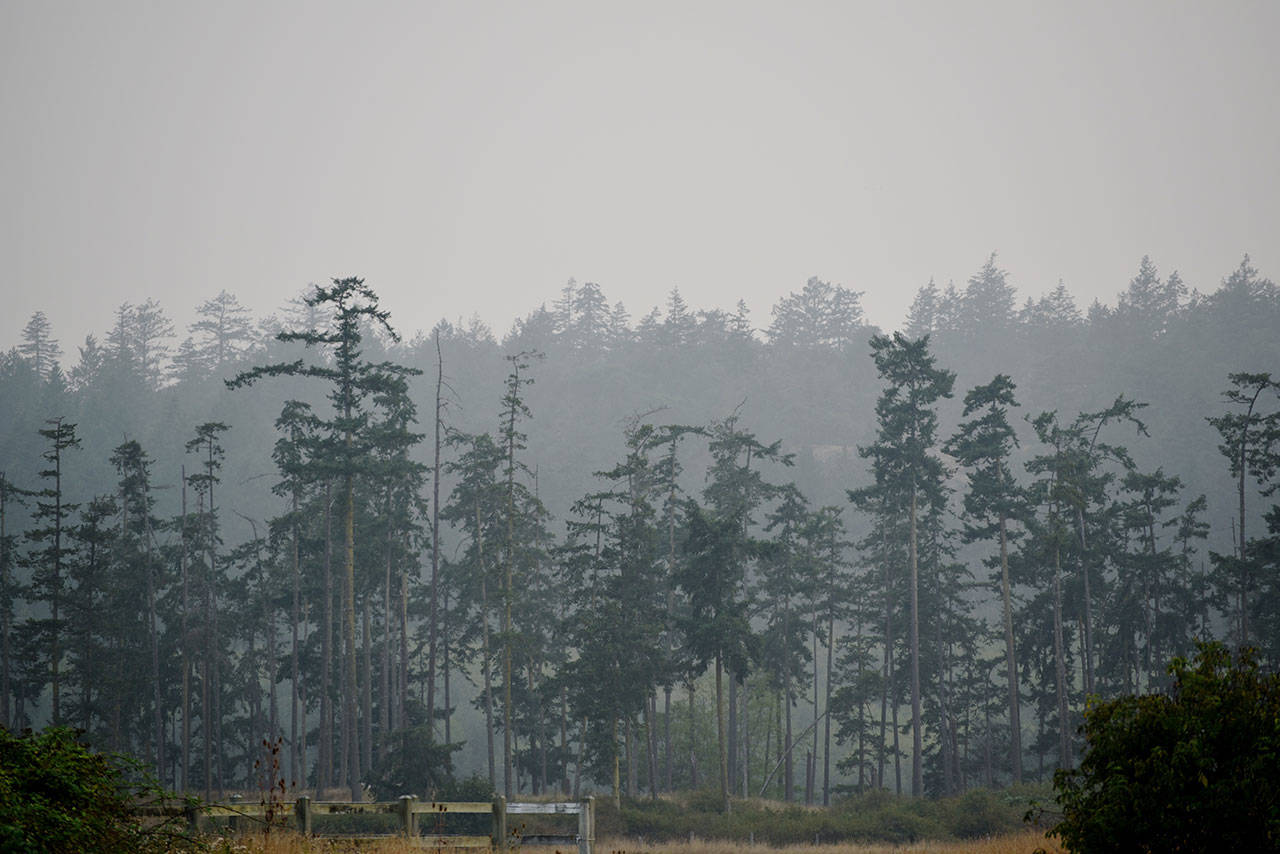The San Juan Islands’ blue cloudless skies and unfiltered rays have been intermittently overshadowed by a gray haze from nearby wildfires for over a week, before a wind change started to blow the smoke out of the region on Thursday, Aug. 23.
Smoke from more than 500 fires in British Columbia, as well as nearly a dozen in eastern Washington, have been drifting over the Puget Sound and the Salish Sea, creating health risks, including coughing, eye irritation and asthma aggravation.
At times, the islands’ air has smelled like campfires. Friday Harbor High School football practice was moved inside, and San Juan Airlines had to cancel almost all of their flights from Monday, Aug. 20, through Wednesday, Aug. 22, in the area.
Despite such anecdotal evidence, there is no data on the exact levels of county air pollutants because there are no air monitoring devices in the islands. Kyle Dodd, the environmental resource manager for the county, said the Washington State Department of Ecology will place an air quality monitoring device in Friday Harbor from October 2018 through March 2019.
Katie Skipper, with the state Department of Ecology’s northwest region, said the temporary device will help staff determine a “baseline” of pollutants in the local air. If the results are drastically different than nearby monitors on the mainland, staff will start planning for a long-term solution.
“We expect the air quality to be pretty good,” she said.
Until then, Dodd suggests neighboring counties’ devices to be used as indicators of the islands’ air conditions.
When nearby counties release reports about unhealthy air quality in their region, authorities are measuring what is known as fine particulates in the air, which are believed to pose the largest health risks. According to Andrew Wineke, a media representative for the Washington State Department of Ecology, the closest monitor to the islands is in downtown Anacortes, roughly 20 miles from Friday Harbor.
For most of Tuesday, Aug. 21 and Wednesday, Aug. 22, this device measured levels that the Washington State Department of Ecology classifies as “very unhealthy.” It is the second-highest classification on the department’s air monitoring chart and states that “everyone should stay indoors, avoid all strenuous activity, close windows and doors if it’s not too hot, set your air conditioning to recirculate, and use a high-efficiency particulate air filter if possible.”
“That fine particle pollution, it’s the microscopic stuff that you can’t see,” said Wineke. “You breathe it in, it gets into your lungs, it gets into your bloodstream and that’s what we’re most concerned about.”
The state Department of Ecology’s staff oversees air quality control in the San Juans and most of eastern Washington. They have monitoring devices in some of those locations but not the islands.
Other areas are managed by one of seven clean air agencies in the state. Four of these agencies cover multiple counties, like the Northwest Clean Air Agency which was formed by Island, Whatcom and Skagit counties, and three cover individual counties, like the Spokane Regional Clean Air Agency.
Seth Preston, with Northwest Clean Air Agency, said the organization has seven monitors in the three counties under its jurisdiction, including the one in downtown Anacortes.
Preston said the agency cannot comment on air quality in the islands; the San Juans is not in their jurisdiction and they do not have any measuring devices in the county. However, pollutants measured can vary greatly by location. For instance, on Aug. 21, the downtown Anacortes monitor was measuring pollutants three levels higher than one about 10 minutes away. The monitor downtown is in a more densely populated area than the other, said Preston, which could explain the different readings.
As a result of the smoke and dry conditions, fire bans have been enacted throughout the Department of Natural Resources’ lands, as well as San Juan and nearby counties.
On Aug. 21, county staff banned outdoor fires of any kind, including recreational flames and the use of backyard fire kettles, chimneys or fire pits. These changes are likely to continue into the fall.
The same day, the San Juan Island National Historical Park staff also prohibited the following at American Camp and English Camp: building, maintaining, attending or using a fire or campfire, charcoal grill, tiki torches, incense burners, candles, propane campfires or wood burning stoves, including in developed picnic grounds.
To read more about protecting yourself against unhealthy air, visit wasmoke.blogspot.com. To review the air quality monitors in Washington, visit https://fortress.wa.gov/ecy/enviwa.



